Management Accounting: Financial Decision Analysis Report
VerifiedAdded on 2020/05/28
|10
|1943
|33
Report
AI Summary
This management accounting report presents a detailed financial analysis of various scenarios within the airline industry. The report begins by evaluating the decision of whether to replace an old truck loader with a new one, calculating differential costs to determine the most cost-effective option. It then analyzes two flight route scenarios: a non-stop route versus a route with a stopover, assessing passenger and cargo revenue, landing fees, and operational costs to identify the most financially beneficial choice. Finally, the report examines the acceptance of special tourist charter flights, considering situations with and without spare capacity, to determine the impact on profit and loss. The analysis includes calculations of revenue, variable expenses, fixed costs, and profit, providing a comprehensive understanding of financial decision-making in the context of airline management. The report references several academic sources to support its findings.
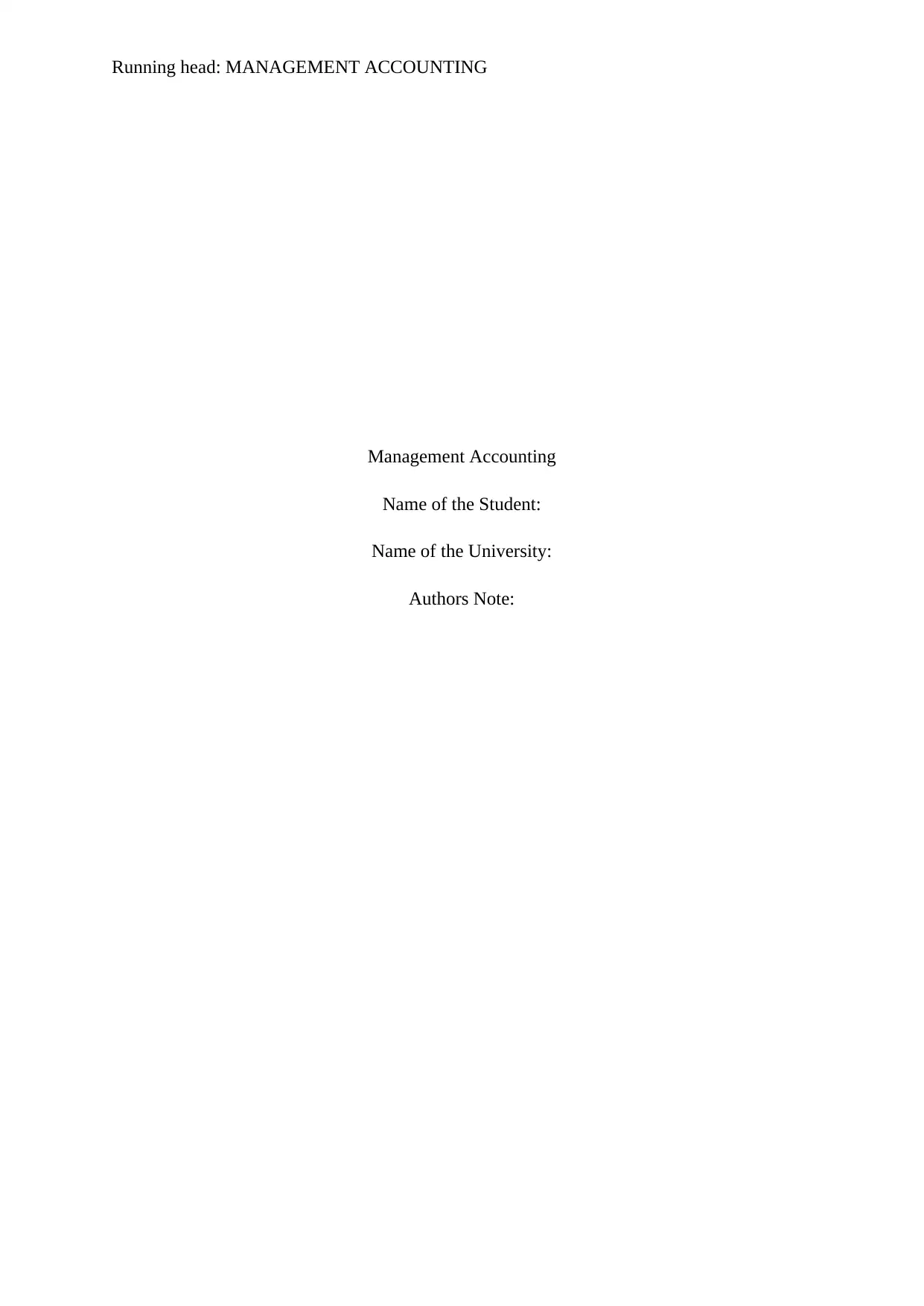
Running head: MANAGEMENT ACCOUNTING
Management Accounting
Name of the Student:
Name of the University:
Authors Note:
Management Accounting
Name of the Student:
Name of the University:
Authors Note:
Paraphrase This Document
Need a fresh take? Get an instant paraphrase of this document with our AI Paraphraser

MANAGEMENT ACCOUNTING
1
Table of Contents
Situation 1:.................................................................................................................................2
Depicting with calculations the decision made by the airlines for using new or old truck for
their services:.............................................................................................................................2
Situation 2:.................................................................................................................................3
A) On purely the financial grounds should the flight Airline uses flight route with stopover:. 3
B) Discussing the factors that needs to be discussed:................................................................5
Situation 3:.................................................................................................................................6
A) Discussing whether to accept special tourist charter flight when spare capacity is present: 6
B) Discussing whether to accept special tourist charter flight when no spare capacity is
present:.......................................................................................................................................7
Reference and Bibliography:......................................................................................................9
1
Table of Contents
Situation 1:.................................................................................................................................2
Depicting with calculations the decision made by the airlines for using new or old truck for
their services:.............................................................................................................................2
Situation 2:.................................................................................................................................3
A) On purely the financial grounds should the flight Airline uses flight route with stopover:. 3
B) Discussing the factors that needs to be discussed:................................................................5
Situation 3:.................................................................................................................................6
A) Discussing whether to accept special tourist charter flight when spare capacity is present: 6
B) Discussing whether to accept special tourist charter flight when no spare capacity is
present:.......................................................................................................................................7
Reference and Bibliography:......................................................................................................9
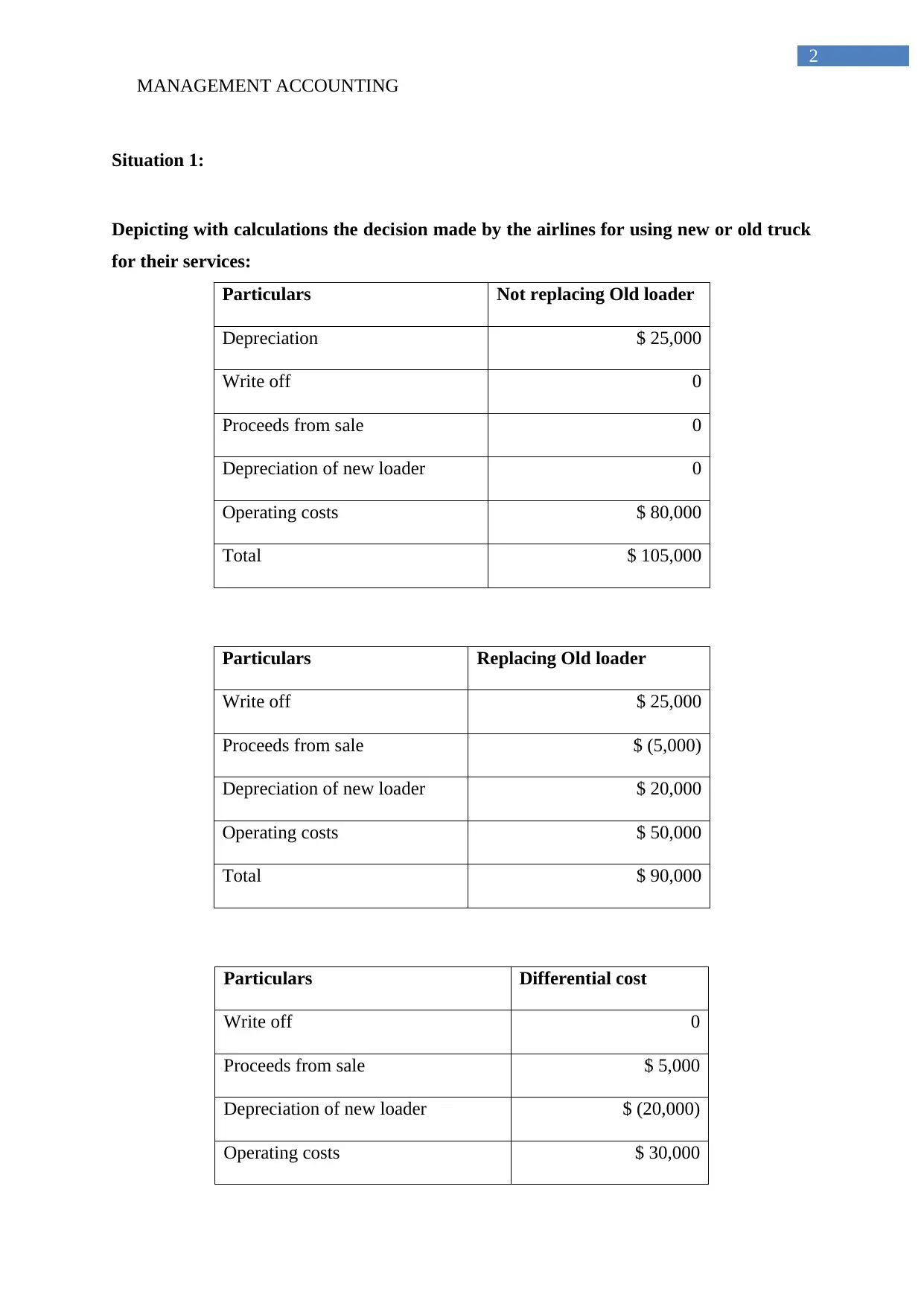
MANAGEMENT ACCOUNTING
2
Situation 1:
Depicting with calculations the decision made by the airlines for using new or old truck
for their services:
Particulars Not replacing Old loader
Depreciation $ 25,000
Write off 0
Proceeds from sale 0
Depreciation of new loader 0
Operating costs $ 80,000
Total $ 105,000
Particulars Replacing Old loader
Write off $ 25,000
Proceeds from sale $ (5,000)
Depreciation of new loader $ 20,000
Operating costs $ 50,000
Total $ 90,000
Particulars Differential cost
Write off 0
Proceeds from sale $ 5,000
Depreciation of new loader $ (20,000)
Operating costs $ 30,000
2
Situation 1:
Depicting with calculations the decision made by the airlines for using new or old truck
for their services:
Particulars Not replacing Old loader
Depreciation $ 25,000
Write off 0
Proceeds from sale 0
Depreciation of new loader 0
Operating costs $ 80,000
Total $ 105,000
Particulars Replacing Old loader
Write off $ 25,000
Proceeds from sale $ (5,000)
Depreciation of new loader $ 20,000
Operating costs $ 50,000
Total $ 90,000
Particulars Differential cost
Write off 0
Proceeds from sale $ 5,000
Depreciation of new loader $ (20,000)
Operating costs $ 30,000
⊘ This is a preview!⊘
Do you want full access?
Subscribe today to unlock all pages.

Trusted by 1+ million students worldwide
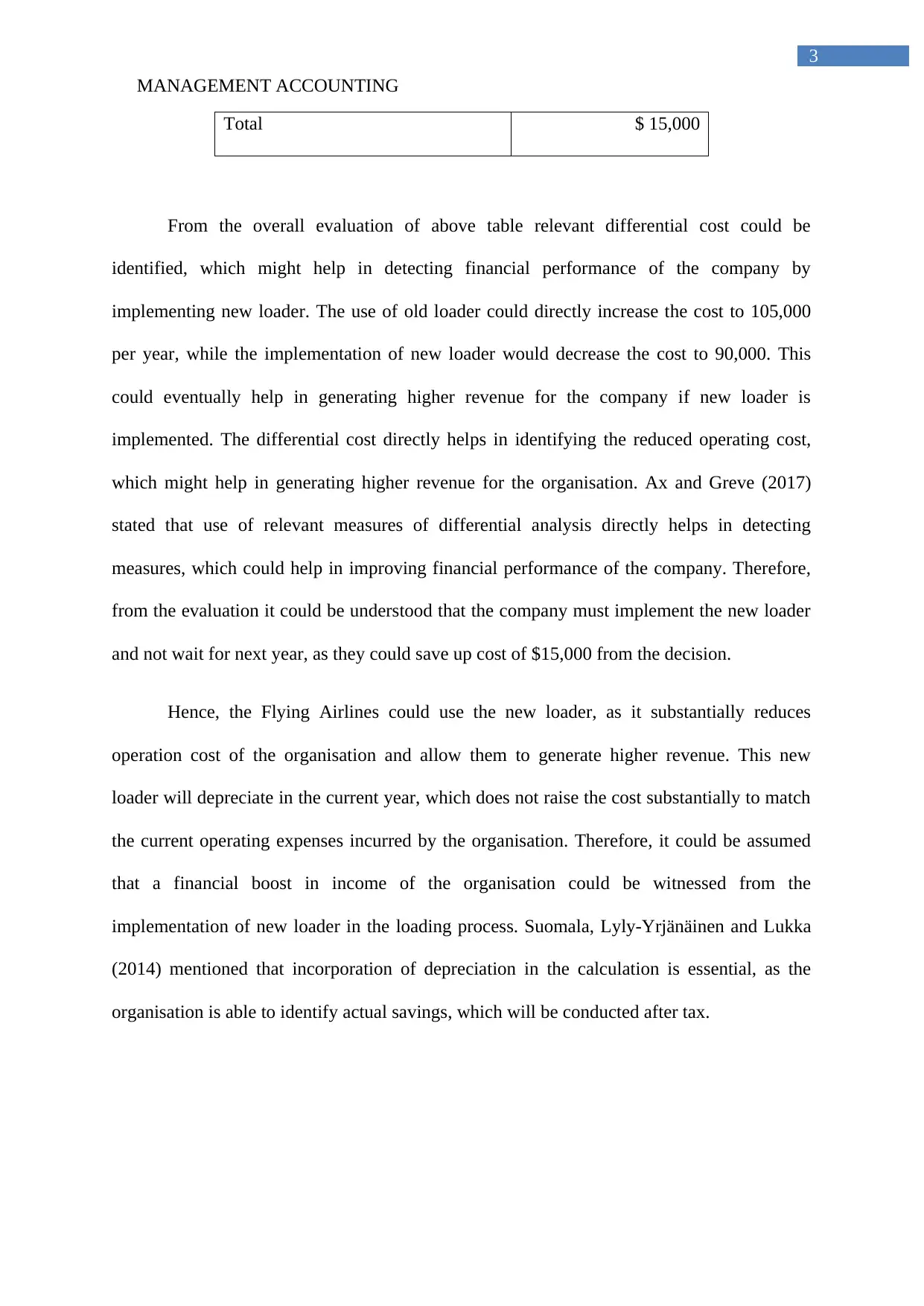
MANAGEMENT ACCOUNTING
3
Total $ 15,000
From the overall evaluation of above table relevant differential cost could be
identified, which might help in detecting financial performance of the company by
implementing new loader. The use of old loader could directly increase the cost to 105,000
per year, while the implementation of new loader would decrease the cost to 90,000. This
could eventually help in generating higher revenue for the company if new loader is
implemented. The differential cost directly helps in identifying the reduced operating cost,
which might help in generating higher revenue for the organisation. Ax and Greve (2017)
stated that use of relevant measures of differential analysis directly helps in detecting
measures, which could help in improving financial performance of the company. Therefore,
from the evaluation it could be understood that the company must implement the new loader
and not wait for next year, as they could save up cost of $15,000 from the decision.
Hence, the Flying Airlines could use the new loader, as it substantially reduces
operation cost of the organisation and allow them to generate higher revenue. This new
loader will depreciate in the current year, which does not raise the cost substantially to match
the current operating expenses incurred by the organisation. Therefore, it could be assumed
that a financial boost in income of the organisation could be witnessed from the
implementation of new loader in the loading process. Suomala, Lyly-Yrjänäinen and Lukka
(2014) mentioned that incorporation of depreciation in the calculation is essential, as the
organisation is able to identify actual savings, which will be conducted after tax.
3
Total $ 15,000
From the overall evaluation of above table relevant differential cost could be
identified, which might help in detecting financial performance of the company by
implementing new loader. The use of old loader could directly increase the cost to 105,000
per year, while the implementation of new loader would decrease the cost to 90,000. This
could eventually help in generating higher revenue for the company if new loader is
implemented. The differential cost directly helps in identifying the reduced operating cost,
which might help in generating higher revenue for the organisation. Ax and Greve (2017)
stated that use of relevant measures of differential analysis directly helps in detecting
measures, which could help in improving financial performance of the company. Therefore,
from the evaluation it could be understood that the company must implement the new loader
and not wait for next year, as they could save up cost of $15,000 from the decision.
Hence, the Flying Airlines could use the new loader, as it substantially reduces
operation cost of the organisation and allow them to generate higher revenue. This new
loader will depreciate in the current year, which does not raise the cost substantially to match
the current operating expenses incurred by the organisation. Therefore, it could be assumed
that a financial boost in income of the organisation could be witnessed from the
implementation of new loader in the loading process. Suomala, Lyly-Yrjänäinen and Lukka
(2014) mentioned that incorporation of depreciation in the calculation is essential, as the
organisation is able to identify actual savings, which will be conducted after tax.
Paraphrase This Document
Need a fresh take? Get an instant paraphrase of this document with our AI Paraphraser
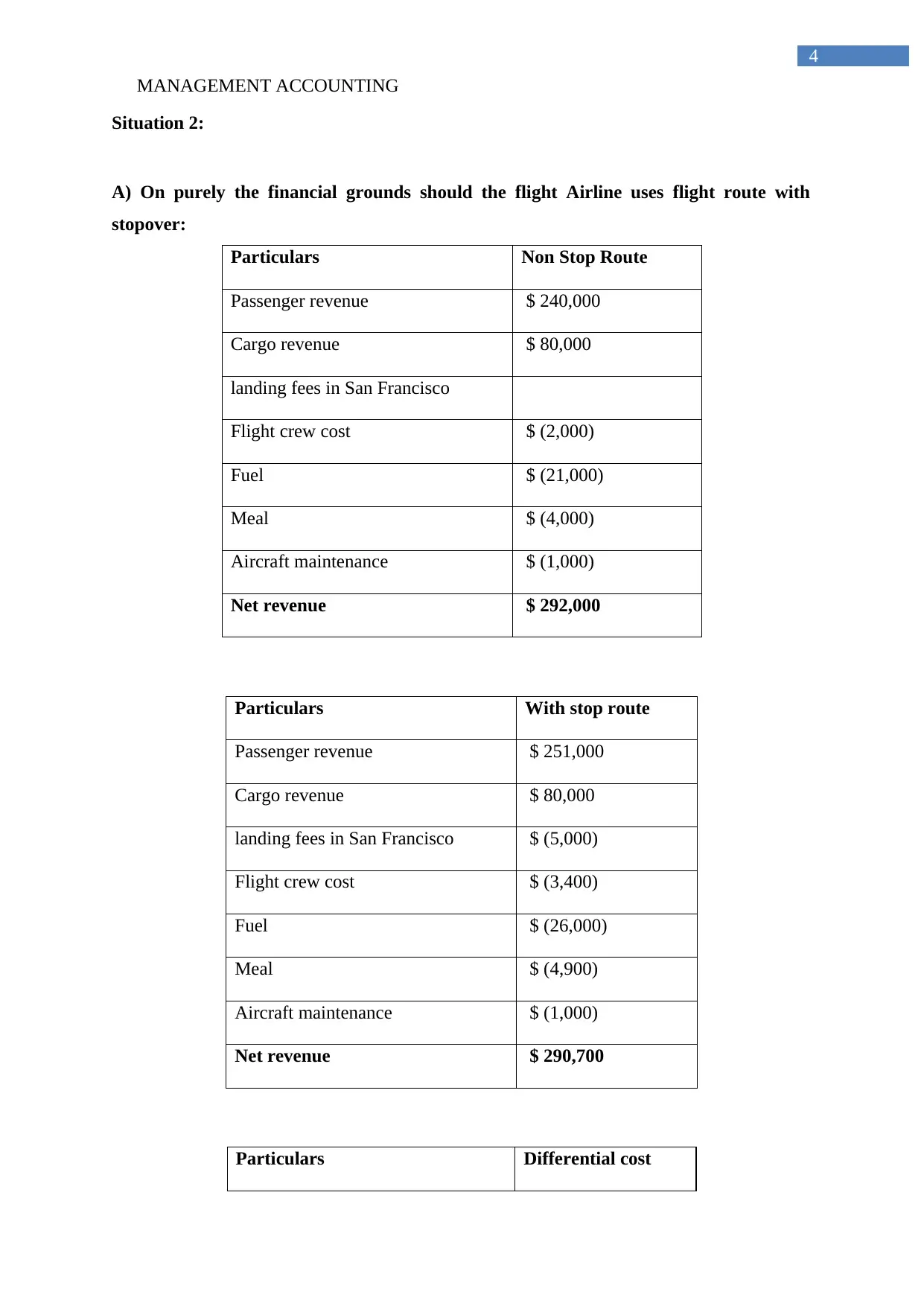
MANAGEMENT ACCOUNTING
4
Situation 2:
A) On purely the financial grounds should the flight Airline uses flight route with
stopover:
Particulars Non Stop Route
Passenger revenue $ 240,000
Cargo revenue $ 80,000
landing fees in San Francisco
Flight crew cost $ (2,000)
Fuel $ (21,000)
Meal $ (4,000)
Aircraft maintenance $ (1,000)
Net revenue $ 292,000
Particulars With stop route
Passenger revenue $ 251,000
Cargo revenue $ 80,000
landing fees in San Francisco $ (5,000)
Flight crew cost $ (3,400)
Fuel $ (26,000)
Meal $ (4,900)
Aircraft maintenance $ (1,000)
Net revenue $ 290,700
Particulars Differential cost
4
Situation 2:
A) On purely the financial grounds should the flight Airline uses flight route with
stopover:
Particulars Non Stop Route
Passenger revenue $ 240,000
Cargo revenue $ 80,000
landing fees in San Francisco
Flight crew cost $ (2,000)
Fuel $ (21,000)
Meal $ (4,000)
Aircraft maintenance $ (1,000)
Net revenue $ 292,000
Particulars With stop route
Passenger revenue $ 251,000
Cargo revenue $ 80,000
landing fees in San Francisco $ (5,000)
Flight crew cost $ (3,400)
Fuel $ (26,000)
Meal $ (4,900)
Aircraft maintenance $ (1,000)
Net revenue $ 290,700
Particulars Differential cost
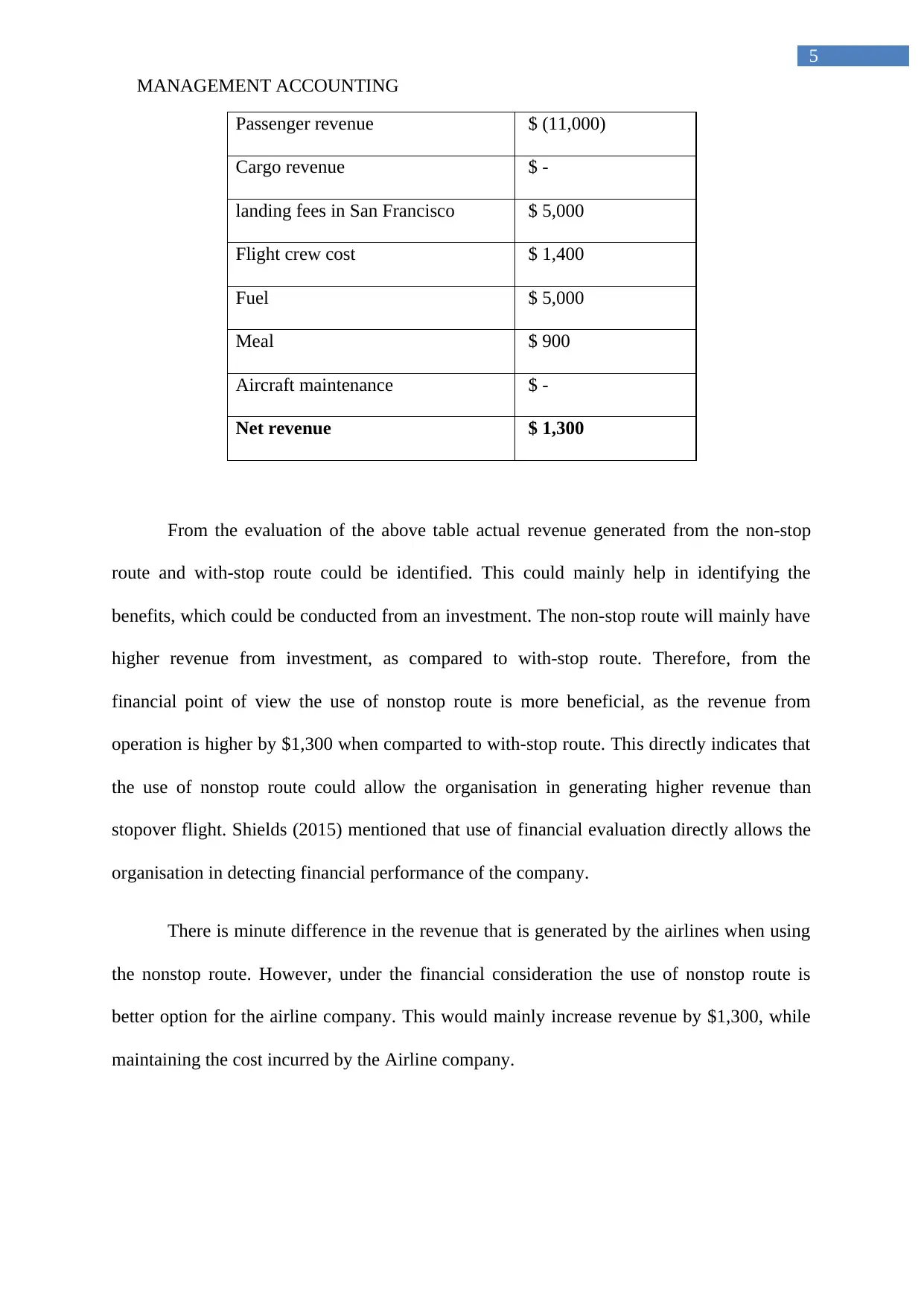
MANAGEMENT ACCOUNTING
5
Passenger revenue $ (11,000)
Cargo revenue $ -
landing fees in San Francisco $ 5,000
Flight crew cost $ 1,400
Fuel $ 5,000
Meal $ 900
Aircraft maintenance $ -
Net revenue $ 1,300
From the evaluation of the above table actual revenue generated from the non-stop
route and with-stop route could be identified. This could mainly help in identifying the
benefits, which could be conducted from an investment. The non-stop route will mainly have
higher revenue from investment, as compared to with-stop route. Therefore, from the
financial point of view the use of nonstop route is more beneficial, as the revenue from
operation is higher by $1,300 when comparted to with-stop route. This directly indicates that
the use of nonstop route could allow the organisation in generating higher revenue than
stopover flight. Shields (2015) mentioned that use of financial evaluation directly allows the
organisation in detecting financial performance of the company.
There is minute difference in the revenue that is generated by the airlines when using
the nonstop route. However, under the financial consideration the use of nonstop route is
better option for the airline company. This would mainly increase revenue by $1,300, while
maintaining the cost incurred by the Airline company.
5
Passenger revenue $ (11,000)
Cargo revenue $ -
landing fees in San Francisco $ 5,000
Flight crew cost $ 1,400
Fuel $ 5,000
Meal $ 900
Aircraft maintenance $ -
Net revenue $ 1,300
From the evaluation of the above table actual revenue generated from the non-stop
route and with-stop route could be identified. This could mainly help in identifying the
benefits, which could be conducted from an investment. The non-stop route will mainly have
higher revenue from investment, as compared to with-stop route. Therefore, from the
financial point of view the use of nonstop route is more beneficial, as the revenue from
operation is higher by $1,300 when comparted to with-stop route. This directly indicates that
the use of nonstop route could allow the organisation in generating higher revenue than
stopover flight. Shields (2015) mentioned that use of financial evaluation directly allows the
organisation in detecting financial performance of the company.
There is minute difference in the revenue that is generated by the airlines when using
the nonstop route. However, under the financial consideration the use of nonstop route is
better option for the airline company. This would mainly increase revenue by $1,300, while
maintaining the cost incurred by the Airline company.
⊘ This is a preview!⊘
Do you want full access?
Subscribe today to unlock all pages.

Trusted by 1+ million students worldwide
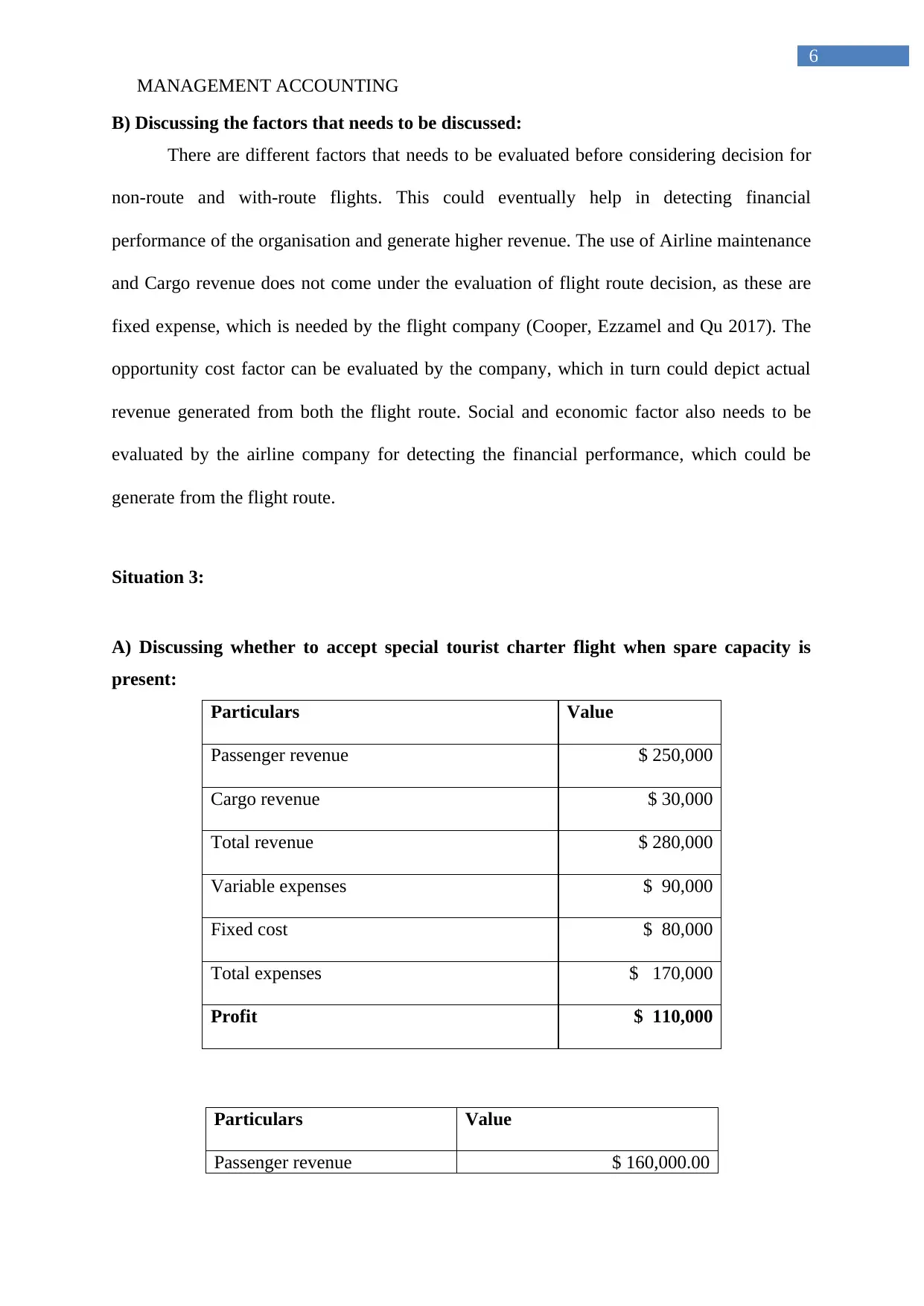
MANAGEMENT ACCOUNTING
6
B) Discussing the factors that needs to be discussed:
There are different factors that needs to be evaluated before considering decision for
non-route and with-route flights. This could eventually help in detecting financial
performance of the organisation and generate higher revenue. The use of Airline maintenance
and Cargo revenue does not come under the evaluation of flight route decision, as these are
fixed expense, which is needed by the flight company (Cooper, Ezzamel and Qu 2017). The
opportunity cost factor can be evaluated by the company, which in turn could depict actual
revenue generated from both the flight route. Social and economic factor also needs to be
evaluated by the airline company for detecting the financial performance, which could be
generate from the flight route.
Situation 3:
A) Discussing whether to accept special tourist charter flight when spare capacity is
present:
Particulars Value
Passenger revenue $ 250,000
Cargo revenue $ 30,000
Total revenue $ 280,000
Variable expenses $ 90,000
Fixed cost $ 80,000
Total expenses $ 170,000
Profit $ 110,000
Particulars Value
Passenger revenue $ 160,000.00
6
B) Discussing the factors that needs to be discussed:
There are different factors that needs to be evaluated before considering decision for
non-route and with-route flights. This could eventually help in detecting financial
performance of the organisation and generate higher revenue. The use of Airline maintenance
and Cargo revenue does not come under the evaluation of flight route decision, as these are
fixed expense, which is needed by the flight company (Cooper, Ezzamel and Qu 2017). The
opportunity cost factor can be evaluated by the company, which in turn could depict actual
revenue generated from both the flight route. Social and economic factor also needs to be
evaluated by the airline company for detecting the financial performance, which could be
generate from the flight route.
Situation 3:
A) Discussing whether to accept special tourist charter flight when spare capacity is
present:
Particulars Value
Passenger revenue $ 250,000
Cargo revenue $ 30,000
Total revenue $ 280,000
Variable expenses $ 90,000
Fixed cost $ 80,000
Total expenses $ 170,000
Profit $ 110,000
Particulars Value
Passenger revenue $ 160,000.00
Paraphrase This Document
Need a fresh take? Get an instant paraphrase of this document with our AI Paraphraser
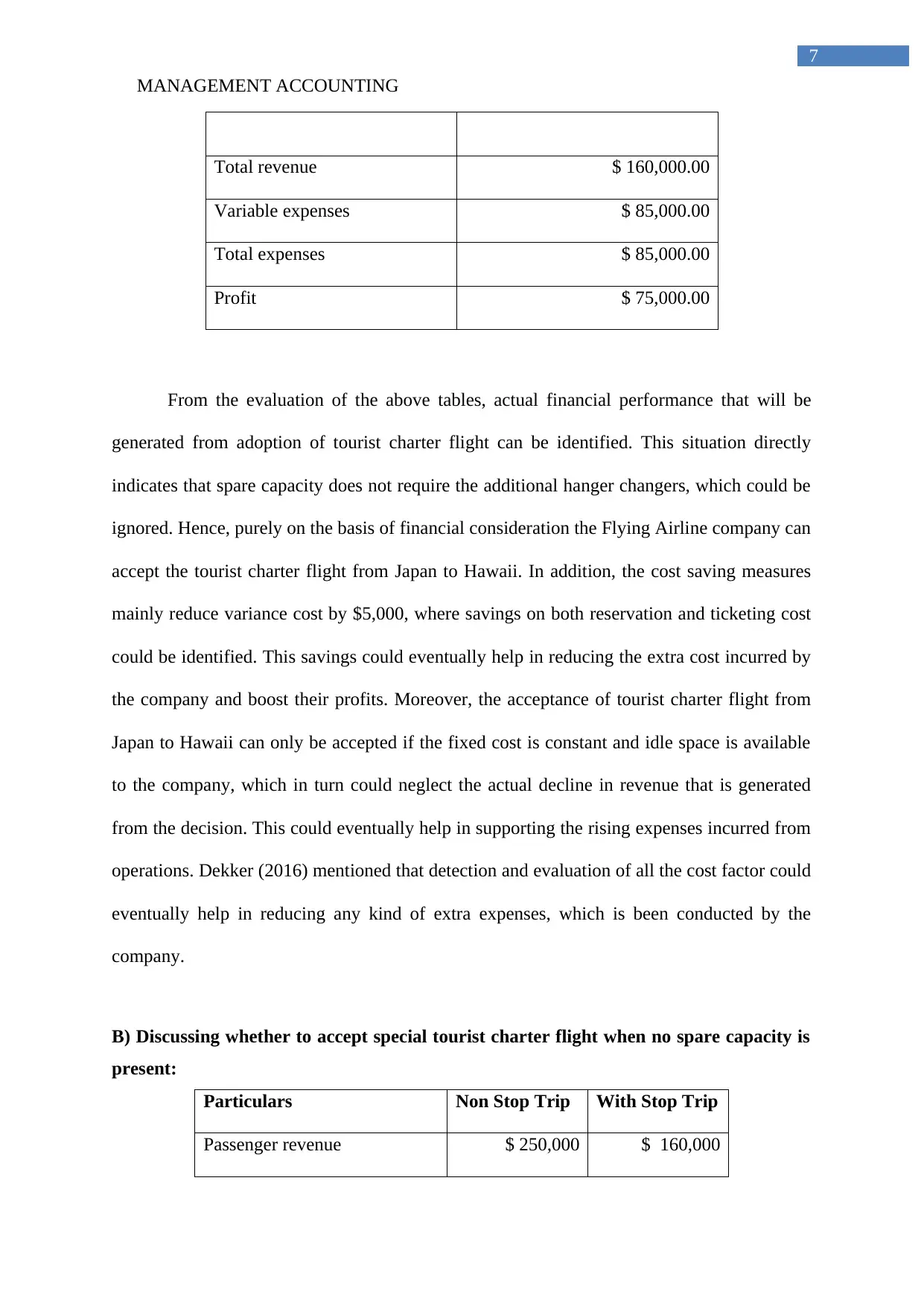
MANAGEMENT ACCOUNTING
7
Total revenue $ 160,000.00
Variable expenses $ 85,000.00
Total expenses $ 85,000.00
Profit $ 75,000.00
From the evaluation of the above tables, actual financial performance that will be
generated from adoption of tourist charter flight can be identified. This situation directly
indicates that spare capacity does not require the additional hanger changers, which could be
ignored. Hence, purely on the basis of financial consideration the Flying Airline company can
accept the tourist charter flight from Japan to Hawaii. In addition, the cost saving measures
mainly reduce variance cost by $5,000, where savings on both reservation and ticketing cost
could be identified. This savings could eventually help in reducing the extra cost incurred by
the company and boost their profits. Moreover, the acceptance of tourist charter flight from
Japan to Hawaii can only be accepted if the fixed cost is constant and idle space is available
to the company, which in turn could neglect the actual decline in revenue that is generated
from the decision. This could eventually help in supporting the rising expenses incurred from
operations. Dekker (2016) mentioned that detection and evaluation of all the cost factor could
eventually help in reducing any kind of extra expenses, which is been conducted by the
company.
B) Discussing whether to accept special tourist charter flight when no spare capacity is
present:
Particulars Non Stop Trip With Stop Trip
Passenger revenue $ 250,000 $ 160,000
7
Total revenue $ 160,000.00
Variable expenses $ 85,000.00
Total expenses $ 85,000.00
Profit $ 75,000.00
From the evaluation of the above tables, actual financial performance that will be
generated from adoption of tourist charter flight can be identified. This situation directly
indicates that spare capacity does not require the additional hanger changers, which could be
ignored. Hence, purely on the basis of financial consideration the Flying Airline company can
accept the tourist charter flight from Japan to Hawaii. In addition, the cost saving measures
mainly reduce variance cost by $5,000, where savings on both reservation and ticketing cost
could be identified. This savings could eventually help in reducing the extra cost incurred by
the company and boost their profits. Moreover, the acceptance of tourist charter flight from
Japan to Hawaii can only be accepted if the fixed cost is constant and idle space is available
to the company, which in turn could neglect the actual decline in revenue that is generated
from the decision. This could eventually help in supporting the rising expenses incurred from
operations. Dekker (2016) mentioned that detection and evaluation of all the cost factor could
eventually help in reducing any kind of extra expenses, which is been conducted by the
company.
B) Discussing whether to accept special tourist charter flight when no spare capacity is
present:
Particulars Non Stop Trip With Stop Trip
Passenger revenue $ 250,000 $ 160,000
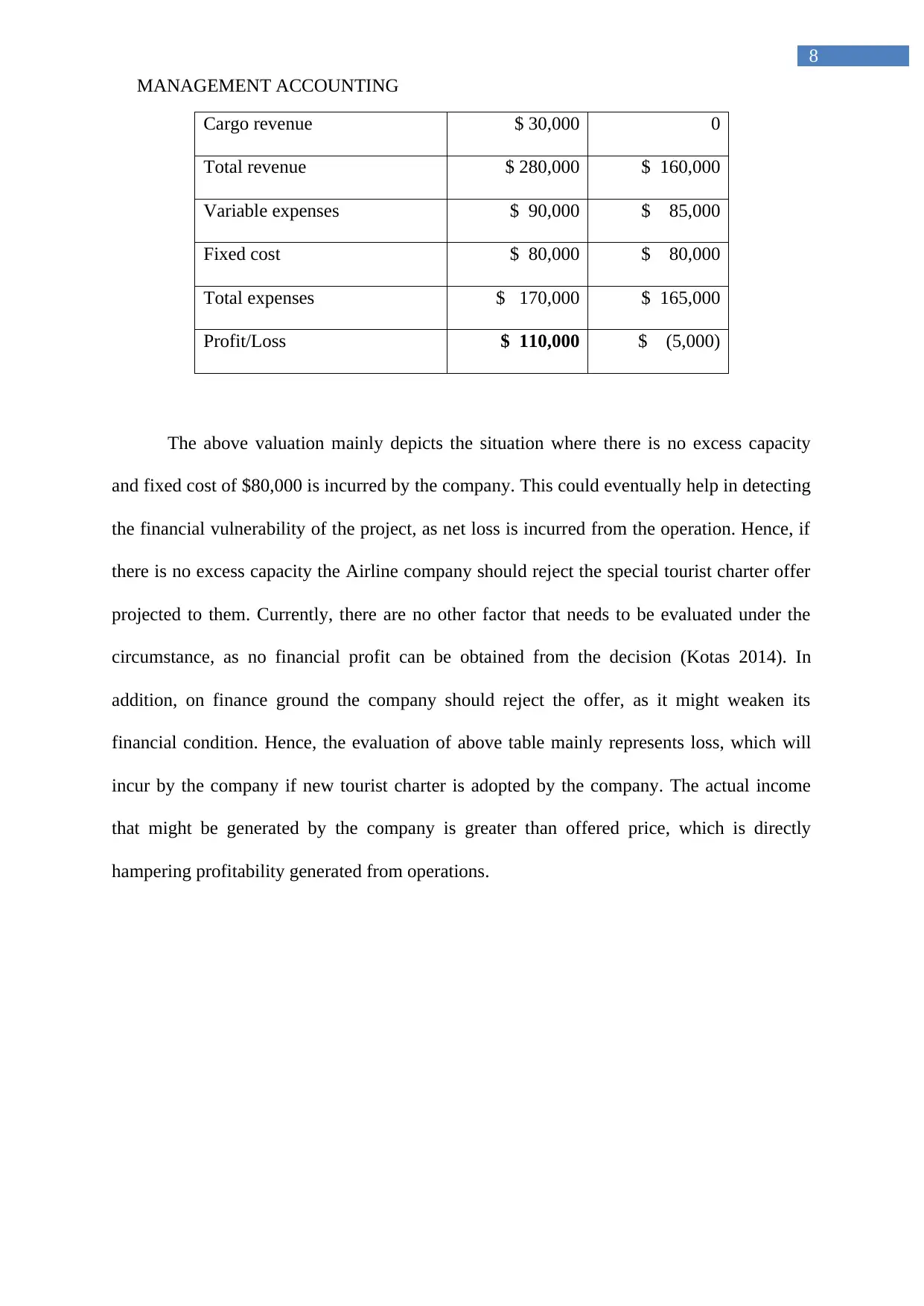
MANAGEMENT ACCOUNTING
8
Cargo revenue $ 30,000 0
Total revenue $ 280,000 $ 160,000
Variable expenses $ 90,000 $ 85,000
Fixed cost $ 80,000 $ 80,000
Total expenses $ 170,000 $ 165,000
Profit/Loss $ 110,000 $ (5,000)
The above valuation mainly depicts the situation where there is no excess capacity
and fixed cost of $80,000 is incurred by the company. This could eventually help in detecting
the financial vulnerability of the project, as net loss is incurred from the operation. Hence, if
there is no excess capacity the Airline company should reject the special tourist charter offer
projected to them. Currently, there are no other factor that needs to be evaluated under the
circumstance, as no financial profit can be obtained from the decision (Kotas 2014). In
addition, on finance ground the company should reject the offer, as it might weaken its
financial condition. Hence, the evaluation of above table mainly represents loss, which will
incur by the company if new tourist charter is adopted by the company. The actual income
that might be generated by the company is greater than offered price, which is directly
hampering profitability generated from operations.
8
Cargo revenue $ 30,000 0
Total revenue $ 280,000 $ 160,000
Variable expenses $ 90,000 $ 85,000
Fixed cost $ 80,000 $ 80,000
Total expenses $ 170,000 $ 165,000
Profit/Loss $ 110,000 $ (5,000)
The above valuation mainly depicts the situation where there is no excess capacity
and fixed cost of $80,000 is incurred by the company. This could eventually help in detecting
the financial vulnerability of the project, as net loss is incurred from the operation. Hence, if
there is no excess capacity the Airline company should reject the special tourist charter offer
projected to them. Currently, there are no other factor that needs to be evaluated under the
circumstance, as no financial profit can be obtained from the decision (Kotas 2014). In
addition, on finance ground the company should reject the offer, as it might weaken its
financial condition. Hence, the evaluation of above table mainly represents loss, which will
incur by the company if new tourist charter is adopted by the company. The actual income
that might be generated by the company is greater than offered price, which is directly
hampering profitability generated from operations.
⊘ This is a preview!⊘
Do you want full access?
Subscribe today to unlock all pages.

Trusted by 1+ million students worldwide
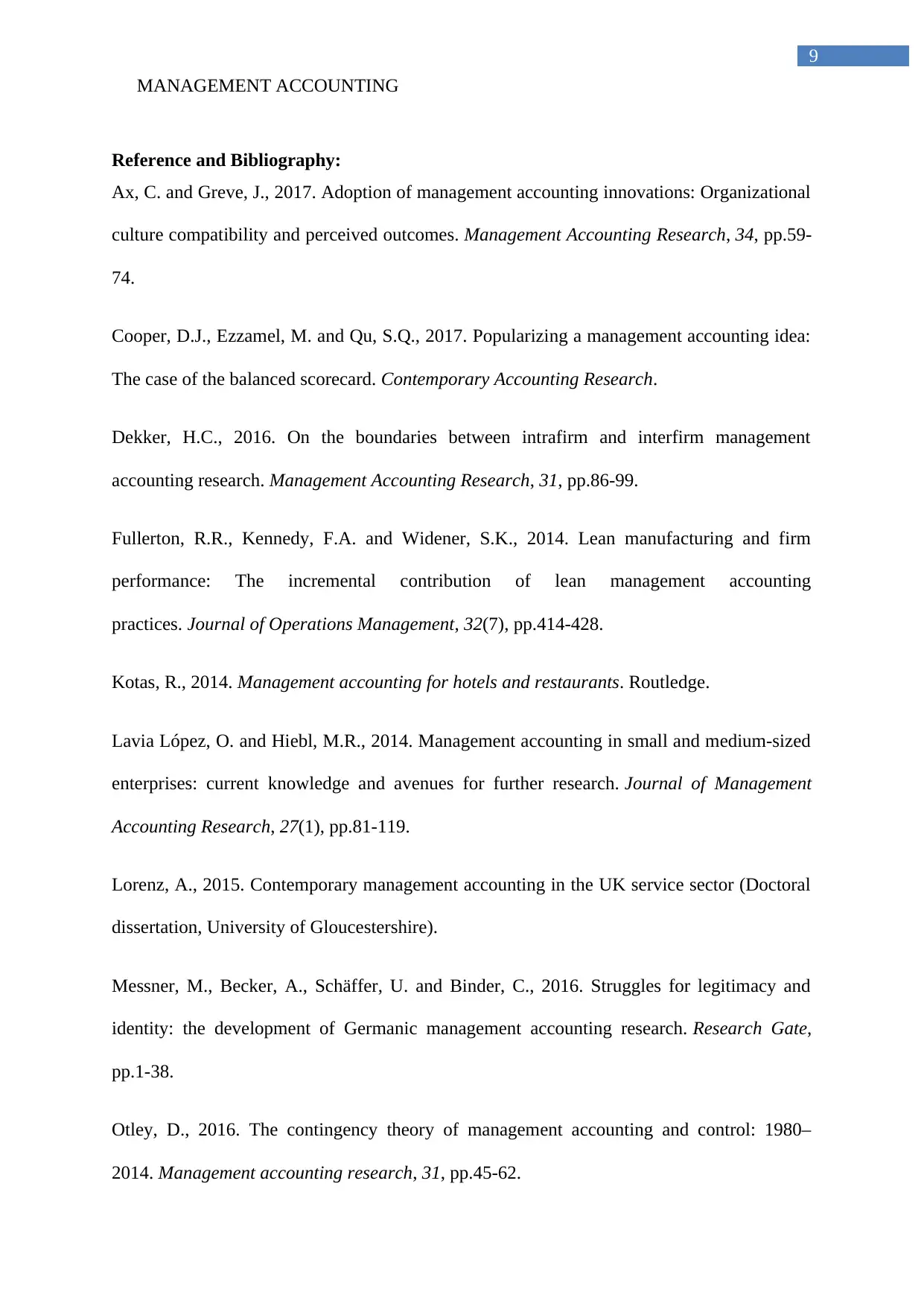
MANAGEMENT ACCOUNTING
9
Reference and Bibliography:
Ax, C. and Greve, J., 2017. Adoption of management accounting innovations: Organizational
culture compatibility and perceived outcomes. Management Accounting Research, 34, pp.59-
74.
Cooper, D.J., Ezzamel, M. and Qu, S.Q., 2017. Popularizing a management accounting idea:
The case of the balanced scorecard. Contemporary Accounting Research.
Dekker, H.C., 2016. On the boundaries between intrafirm and interfirm management
accounting research. Management Accounting Research, 31, pp.86-99.
Fullerton, R.R., Kennedy, F.A. and Widener, S.K., 2014. Lean manufacturing and firm
performance: The incremental contribution of lean management accounting
practices. Journal of Operations Management, 32(7), pp.414-428.
Kotas, R., 2014. Management accounting for hotels and restaurants. Routledge.
Lavia López, O. and Hiebl, M.R., 2014. Management accounting in small and medium-sized
enterprises: current knowledge and avenues for further research. Journal of Management
Accounting Research, 27(1), pp.81-119.
Lorenz, A., 2015. Contemporary management accounting in the UK service sector (Doctoral
dissertation, University of Gloucestershire).
Messner, M., Becker, A., Schäffer, U. and Binder, C., 2016. Struggles for legitimacy and
identity: the development of Germanic management accounting research. Research Gate,
pp.1-38.
Otley, D., 2016. The contingency theory of management accounting and control: 1980–
2014. Management accounting research, 31, pp.45-62.
9
Reference and Bibliography:
Ax, C. and Greve, J., 2017. Adoption of management accounting innovations: Organizational
culture compatibility and perceived outcomes. Management Accounting Research, 34, pp.59-
74.
Cooper, D.J., Ezzamel, M. and Qu, S.Q., 2017. Popularizing a management accounting idea:
The case of the balanced scorecard. Contemporary Accounting Research.
Dekker, H.C., 2016. On the boundaries between intrafirm and interfirm management
accounting research. Management Accounting Research, 31, pp.86-99.
Fullerton, R.R., Kennedy, F.A. and Widener, S.K., 2014. Lean manufacturing and firm
performance: The incremental contribution of lean management accounting
practices. Journal of Operations Management, 32(7), pp.414-428.
Kotas, R., 2014. Management accounting for hotels and restaurants. Routledge.
Lavia López, O. and Hiebl, M.R., 2014. Management accounting in small and medium-sized
enterprises: current knowledge and avenues for further research. Journal of Management
Accounting Research, 27(1), pp.81-119.
Lorenz, A., 2015. Contemporary management accounting in the UK service sector (Doctoral
dissertation, University of Gloucestershire).
Messner, M., Becker, A., Schäffer, U. and Binder, C., 2016. Struggles for legitimacy and
identity: the development of Germanic management accounting research. Research Gate,
pp.1-38.
Otley, D., 2016. The contingency theory of management accounting and control: 1980–
2014. Management accounting research, 31, pp.45-62.
1 out of 10
Related Documents
Your All-in-One AI-Powered Toolkit for Academic Success.
+13062052269
info@desklib.com
Available 24*7 on WhatsApp / Email
![[object Object]](/_next/static/media/star-bottom.7253800d.svg)
Unlock your academic potential
Copyright © 2020–2025 A2Z Services. All Rights Reserved. Developed and managed by ZUCOL.





